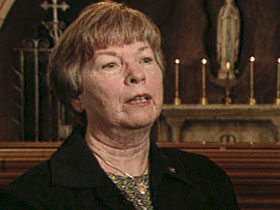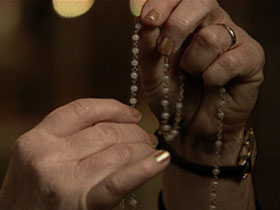BOB ABERNETHY, anchor: For nearly a millennium, part of Roman Catholic prayer life has included saying the rosary, with each rosary bead representing a prayer.
The rosary includes a set of meditations on the life of Christ, known as mysteries. In this country, use of the rosary has diminished in recent years. But many Catholics say it's still part of their practice.
We spoke with Harriet Noye of Wheaton, Maryland and her daughter, Erin, about what saying the rosary means to them.

HARRIET NOYE (reciting the rosary with her daughter and grandchildren): Hail Mary, full of grace, the Lord is with thee. Blessed art thou among women.
When I pray the rosary, I like to think about the word "rosary." "Rosary" means rose garden.
We ask Our Lady to lead us in this rosary tonight, to carry us into her rosary garden. We can walk around with her as we pray.
This is a very special rose garden, the Immaculate Heart of Mary. You retreat from the tensions and stress and anxiety and any problems that you have and put yourself in her Immaculate Heart.
One of the misconceptions that someone who is not Catholic has is that they think we are praying to Mary. We do not adore Mary. We do not worship Mary. We adore God and we worship God. We pray through Mary as an intercessor.
Every rosary should be blessed, by a priest.
As you pray, you move through the beads. You are able to slip your fingers along the beads and you know exactly when you get to these parts that are in between the Hail Mary and the Our Father, and you can close your eyes and just slip along the beads.
Give us the five glorious mysteries. The first glorious mystery is the resurrection. Our Father who art in heaven, hallowed be thy name.

This day our daily bread.
Since the rosary is divided in three parts, a lot of people really just have time to pray one of the mysteries per day. On Mondays are the joyful mysteries, Tuesdays are the sorrowful mysteries, and Wednesdays are the glorious mysteries. And then it starts again. Thursday is joyful; Friday, sorrowful; and Saturday, glorious. Sundays, it depends on the season. If it's Advent, you're praying for joyful. If it's after Easter, glorious. And during Lent, sorrowful.
ERIN (Ms. Noye's daughter): I don't think I do pray as my mother does; she's much more in tune meditatively than I am with the rosary. I'm still a novice, if you will.
Ms. NOYE: I heard where people prayed the three mysteries of the rosary and I thought, "I'll never have time to do something like that. It would just take too long." So I made a little deal with God. I said, "I'll try. I'll really try. But if I can't do it, you know, I'll just stop and I'll go back to just one mystery a day." But I've had no trouble.









